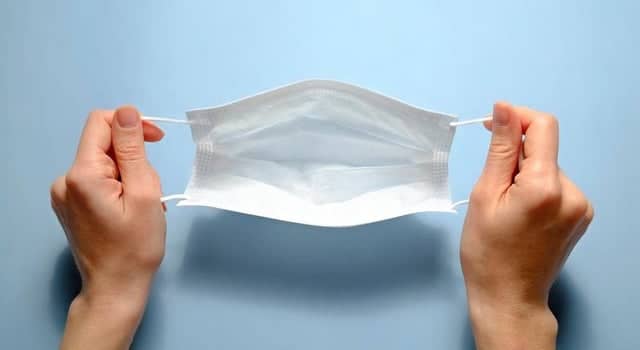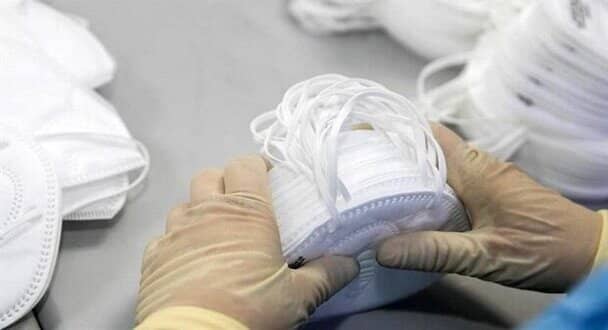Wear a mask ! Perspectives: Med-tech x corona
While hospitals are running out of protective gear, people everywhere in the world are urged to wear masks while shopping. There is a contradiction here. In the debate on the current corona virus crisis a distinction must be made between face masks and personal protective gear. The main components of respirators in healthcare are special non-woven fabrics, but in order to meet urgent demand companies and politicians need to act together.
April 2020
The world is in a state of emergency. No country in the world has enough masks in storage to react to the ongoing health crisis in the best possible way. Dr Klaus Reinhardt, the president of German medical association Bundesärztekammer, is one of the experts worrying about how the protective gear of doctors, practice employees and care staff will protect them against an coronavirus infection. He is appealing to the community and is calling not only on the German Federal Ministry of Health, Bundesministerium für Gesundheit, but on each and every company to help in the current crisis situation. “Whether you are a car supplier or a textile company, each one of us is urged to switch production where possible and start producing protective gear,” Mr Reinhardt said. Many companies like lingerie brand Mey, clothing producer Trigema and car supplier ZF have already followed the call and are now producing masks. But are they really an use there, where they are needed? And what about the contradiction between gear shortages in hospitals and influencer campaigns and government appeals to wear masks in the public?
Face masks versus personal protective gear
Firstly, we need to distinguish between two kinds of masks. Simple cloth masks that cover mouth and nose mainly protect others. If the right material is used and if the masks are used properly, they can curb the spread of larger droplets produced by coughing or sneezing as well as infection through contact with contaminated fingers. Because these masks are neither made for medical use nor do have any self-protective function, they are considered as a clothing item. They are the masks people are supposed to wear in public to prevent the virus from spreading further. On the other hand, people working in close proximity to patients need so-called Personal Protective Equipment (PPE). This equipment includes masks with special meltblown non-woven filters, which prevent the infection with Sars-CoV-2 viruses or other viruses. Such masks include Filtering Facepiece (FFP) masks with varying protective levels. “We can’t stop COVID-19 without protecting health workers first,” says Dr Tedros Adhanom Ghebreyesus, general director of the World Health Organization (WHO). Thus, the primary objective is to provide doctors and care staff with particle filtering respirators.
Many companies want to help, but are very confused. Dr Martin Leonard, chairman of medical technology at German industry association Spectaris, welcomes the “great gesture of solidarity”, but says to be careful: “Good intentions should certainly not backfire at the beds of intensive care patients”. According to Mr Leonard, the fact that there are particular conditions for the right production of protective gear present a big challenge. German textile and fashion association Gesamtverband der deutschen Textil- und Modeindustrie has developed a handbook to help. The guidelines include a detailed differentiation between the different types of masks as well as legal and technical information about guidelines on medical products and choice of material.
Shortages and initiatives
In the EU alone, roughly 250 million surgical masks and 30 to 40 million masks for personal protective equipment would be needed every month to effectively slow down the spread of the coronavirus1. According to European non-wovens association EDANA, there are three types of shortages in the current demand situation that need to be addressed: the production volume of non-wovens, the waiting period for certification and converting capacities. The WHO estimates that production capacity would have to rise by 40%. A quick poll by German medical technology association Bundesverband Medizintechnologie (BVMed) on 18th March 2020 also showed worrying findings: roughly 60% of the med-tech companies interviewed are experiencing problems with their suppliers, approximately one in three companies (35%) is unable to meet the demand for medical protective gear and disinfectants from their own production sites.
The economy stands united. Medical engineering industry association VDMA, the biggest engineering networking organisation in Europe, received an emergency appeal from Bundesministerium für Gesundheit, which was urgently looking for additional production capacity. Within a few weeks, hundreds of companies and initiatives reacted to the association’s appeal. And EDANA is now working closer than ever before with its partners ESF, the European Safety Federation, and Euratex, the European Apparel and Textile Confederation, to find new solutions. In March, EDANA sent a letter to the European Commission asking for all member countries to cooperate to ensure that every production plant could remain fully functional. There have been various political responses. The European Commission will postpone the application date of the Medical Devices Regulation (MDR), originally planned for 26th May 2020, for one year. And the German Corona Cabinet has decided to subsidise producers of meltblown non-wovens by contributing 30% to investment costs for production plants.
The production of basic material will be taken to the highest possible levels, but new local supply chains and partnerships are needed to make the processing of the products possible. Some online networks have already reported success, stating that commodity suppliers, sewing companies and medical and laboratory technical players have teamed up to form cooperative initiatives like the “Need Mask” platform launched by the Institut für Textiltechnik of German university RWTH Aachen Universität. Other companies are taking things into their own hands by bringing production closer to home. German company Dach Schutzbekleidung produces most of its products in China. Following negotiations with the Chinese government, 300,000 respirators and 3 million face masks were delivered to the Bundesministerium für Gesundheit. In order to be more independent, Dach is working on plans to open an exclusively German production plant at its headquarters in Rastatt.
United against the virus
A 1.6 metre wide meltblown plant from German non-woven and meltblown machinery specialist Reifenhäuser Reicofil can produce 500 tons of filter material and 1.8 million respirators a day. In order to add speed to the supply of machines in the current crisis, the machine producer has reduced its delivery periods by one-third to 3.5 months. US packaging and non-woven speciality materials provider Global Berry Group has already made investments and will receive a new plant in June. The virus, however, will not wait until the companies around the world have expanded their plants and production. And the virus does not stop at borders. According to the WHO, there are now more than 2 million confirmed Covid-19 cases in more than 200 countries and regions. No country can fight and defeat the virus alone. Cooperative efforts are needed to increase the production of the necessary commodities and distribute the produced protective gear fairly. The expertise of non-woven fabric producers and their cooperation with med-tech companies is crucial for success and will remain relevant long after the current crisis has ended. Leading trade shows Techtextil and Texprocess with global exhibitors like Freudenberg and Ahlstrom-Munksjo Glassfibre Oy offer accumulated industry knowledge. The trade shows will show exciting technical textiles and non-woven innovations as well as the latest machinery and processes in Frankfurt am Main from 4th to 7th May 2020.
By : Lena M. Kaufmann
#Coronavirus #Covid-19 #World Health Organization #WHO #Freudenberg #Reifenhäuser Reicofil #EDANA #Textil+Mode #Medical technology #Med-tech #Spectaris #Dach Schutzbekleidung #VDMA #RWTH Aachen #BVMed #Non-wovens #Techtextil #Texprocess
1 Edana (2020): “Together we will succeed!” https://www.edana.org/how-we-take-action/covid-19/joining-forces-in-the-battle-against-covid-19
See More TECHNICAL TEXTILE News …
Join Us Now
Join 80.000 Middle East and North Africa Textile Professionals who get Kohan Textile Journal’s FREE Newsletter…
Subscribe Newsletter



















